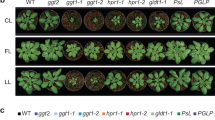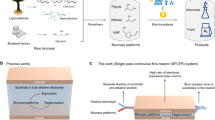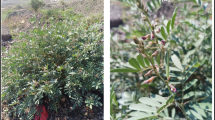Abstract
THE splitting of fructose-1,6-diphosphate to fructose-6-phosphate is an important step in the pentose phosphate reductive pathway of carbohydrate metabolism and in photosynthesis. An absolutely specific, alkaline and magnesium-ion-requiring fructose diphosphatase in spinach leaves has been reported1,2. The leaves contained another fructose diphosphatase with a neutral pH optimum, with no requirement for magnesium ion and capable of splitting also sedoheptulose-1,7-diphosphate2. The presence of a third fructose diphosphatase, with an optimum at acid pH and with activity towards ribulose-1,5-diphosphate also, was reported in spinach leaves3. Racker and Schroeder2 believed that the alkaline fructose diphosphatase did not participate in photosynthesis, being absent from plastids isolated from homogenates prepared in aqueous media. Smillie4, however, obtained evidence to show that alkaline fructose diphosphatase was actively involved in photosynthesis. The enzyme was present in all photosynthetic tissue examined, and, using non-aqueous media for cell disruption, it was possible to show that the activity was localized in the plastids. An investigation by us of the diurnal activity of fructose diphosphatases in the leaves of the tapioca plant (Manihot utillissima) has provided additional evidence, indirectly, for the involvement of the alkaline enzyme in photosynthesis. Homogenates of the leaves showed three distinct pH optima (-acid, neutral and alkaline-) for phosphatase activity towards fructose-1,6-diphosphate. Of these only the alkaline enzyme showed marked diurnal variation in activity, being about three times as active in the daytime as at night.
This is a preview of subscription content, access via your institution
Access options
Subscribe to this journal
Receive 51 print issues and online access
$199.00 per year
only $3.90 per issue
Buy this article
- Purchase on SpringerLink
- Instant access to full article PDF
Prices may be subject to local taxes which are calculated during checkout
Similar content being viewed by others
References
Racker, E., Nature, 175, 249 (1955).
Racker, E., and Schroeder, E. A. R., Arch. Biochem. Biophys., 74, 326 (1958).
Chakravorty, M., Chakrabortty, H. C., and Burma, D. P., Arch. Biochem. Biophys., 82, 21 (1959).
Smillie, R. M., Nature, 187, 1024 (1960).
Lowry, O. H., Rosebrough, N. J., Farr, A. L., and Randall, R. J., J. Biol. Chem. 193, 265 (1951).
Author information
Authors and Affiliations
Rights and permissions
About this article
Cite this article
VISWANATHAN, P., KRISHNAN, P. Role of Alkaline Fructose-1,6-Diphosphatase in Plants. Nature 193, 166–167 (1962). https://doi.org/10.1038/193166a0
Issue date:
DOI: https://doi.org/10.1038/193166a0



